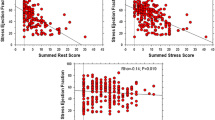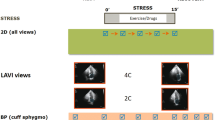Abstract
Left ventricular function during exercise and recovery was investigated in patients with angina pectoris, ST segment depression during exercise and angiographically normal coronary arteries (syndrome X) using a continuous left ventricular function monitor with cadmium telluride detector (CdTe-VEST). Fourteen patients with syndrome X and 14 patients with atypical chest pain without ST segment depression during exercise and normal coronary arteries (control group) performed supine ergometric exercise after administration of 740–925 MBq of technetium-99m labelled red blood cells, and left ventricular function was monitored every 20 s using CdTe-VEST. Left ventricular ejection fraction (EF) response was impaired (≤55% increase from rest to peak exercise) in 11 or 14 patients with syndrome X but in none of the control patients. Resting EF was similar in the two groups (62.1%±6.7% in patients with syndrome X, 61.9%±6.2% in controls); however, EF increase from rest to peak exercise was lower in syndrome X (−3.1±9.5% vs 14.7%±7.4%, P <0.001). After cessation of exercise, all patients showed rapid EF increase over baseline and this EF overshoot was lower (19.3%±8.3% vs 26.4%±7.3%, P <0.001) with the time to EF overshoot longer (114±43 s vs 74±43 s, P<0.05) in patients with syndrome X. Thus, in patients with syndrome X, left ventricular dysfunction was frequently observed during exercise in spite of normal epicardial coronary arteries.
Similar content being viewed by others
References
Kemp HG. Left ventricular function in patients with anginal syndrome and normal coronary arteriogram. Am J Cardiol 1973;32: 375–376
Cannon III RO, Bonow RO, Bacharach SL, Green MV, Rosing DR, Leon MB, Watson RM, Epstein SE. Left ventricular dysfunction in patients with angina pectoris, normal epicardial coronary arteries, and abnormal vasodilator reserve. Circulation 1985;71: 218–226
Arbogast R, Bourassa MG. Myocardial function during arterial pacing in patients with angina pectoris and normal coronary arteriogram: comparison with patients having significant coronary artery disease. Am J Cardiol 1973;32: 257–263
Boudoulas H, Cobb TC, Leighton RF, Wilt SM. Myocardial lactate production in patients with angina-like chest pain and angiographically normal coronary arteries and left ventricle. Am J Cardiol 1974;34: 501–505
Greenberg MA, Grose RM, Neuburger N, Silverman R, Strain JE, Cohen MV. Impaired coronary vasodilator responsiveness as a cause of lactate production during pacing-induced ischemia in patients with angina pectoris and normal coronary arteries. J Am Coll Cardiol 1987;9: 743–751
Ross J Jr. Assessment of ischemic regional myocardial dysfunction and its reversibility. Circulation 1986;74: 1186–1190
Waters DD, Luz PD, Wyatt HL, Swan HJC, Forester JS. Early changes in regional and global left ventricular function induced by graded reduction in regional coronary perfusion. Am J Cardiol 1977;39: 537–543
Hauser AM, Gangadharan V, Ramos RG, Gordon S, Timmis GC. Sequence of mechanical, electrocardiographic and clinical effects of repeated coronary artery occlusion in human beings: electrocardiographic observations during coronary angioplasty. J Am Coll Cardiol 1985;5: 193–197
Taki J, Yasuda T, Tamaki N, Flamm SD, Hutter A, Gold HK, Leinbach R, Strauss HW Temporal relation between left ventricular dysfunction and chest pain in coronary artery disease during activities of daily living. Am J Cardiol 1990;66: 1455–1458
Taki J, Muramori A, Nakajima K, Bunko H, Kawasuji M, Tonami N, Hisada K. Application of a continuous ventricular function monitor to patients with coronary artery bypass grafting. J Nucl Med 1992;33: 441–447
Jones RH, McEwan P, Newman GE, Port S, Rerych SK, Scholz PM, Upton MT, Peter CA, Austin EH, Leong K, Gibbons RJ, Cobb FR, Coleman RE, Sabiston DC Jr. Accuracy of diagnosis of coronary artery disease by radionuclide measurement of left ventricular function during rest and exercise. Circulation 1981;64: 586–601
Rozanski A, Diamond GA, Berman D, Forrester JS, Morris D, Swan HJC. The declining specificity of exercise radionuclide ventriculography. N Engl J Med 1983;309: 518–522
Osbakken MD, Boucher CA, Okad RD, Bingham JB, Strauss HW, Pohost GM. Spectrum of global left ventricular responses to supine exercise. Limitation in the use of ejection fraction in identofying patients with coronary artery disease. Am J Cardiol 1983;51: 28–35
Legrand V, Hodgson JMc, Bates ER, Aureon FM, Mancini GBJ, Smith JS, Gross MD, Vogel RA. Abnormal coronary flow reserve and abnormal radionuclide exercise test results in patients with normal coronary angiograms. J Am Coll Cardiol 1985;6: 1245–1253
Bortone AS, Hess OM, Eberli FR, Nonogi H, Marolf AP, Grimm J, Krayenbuehl. Abnormal coronary vasomotion during exercise in patients with normal coronary arteries and reduced coronary flow reserve. Circulation 1989;79: 516–527
Maseri A, Crea F, Kaski JC, Crake T. Mechanism of angina pectoris in synodrome X. J Am Coll Cardiol 1991;17: 499–506
Berger HJ, Sands MJ, Davies RA, Wackers FJTH, Alexander J, Lachman AS, Williams BW, Zaret BL. Exercise left ventricular performance in patients with chest pain, ischemic-appearing exercise electrocardiograms, and angiographically normal coronary arteries. Ann Intern Med 1981;94: 186–191
Favaro L, Chaplin JL, Fettiche J, Dymond DS. Sex differences in exercise induced left ventricular dysfunction in patients with syndrome X. Br Heart J 1987;57: 232–236
Gibbons RJ, Lee KL, Cobb F, Jones RH. Ejection fraction response to exercise in patients with chest pain and normal coronary arteriograms. Circulation 1981;64: 952–957
Nihoyannopoulos P, Kaski JC, Crake T, Maseri A. Absence of myocardial dysfunction during stress in patients with syndrome X. J Am Coll Cardiol 1991;18: 1463–1470
Picano E, Lattanzi F, Masini M, Distante A, Uabbate A. Usefulness of a high-dose dipyridamole-echocardiography test for diagnosis of syndrome X. Am J Cardiol 1987;60: 508–512
Author information
Authors and Affiliations
Additional information
Correspondence to: J. Taki
Rights and permissions
About this article
Cite this article
Taki, J., Nakajima, K., Muramoril, A. et al. Left ventricular dysfunction during exercise in patients with angina pectoris and angiographically normal coronary arteries (syndrome X). Eur J Nucl Med 21, 98–102 (1994). https://doi.org/10.1007/BF00175754
Received:
Revised:
Issue Date:
DOI: https://doi.org/10.1007/BF00175754




